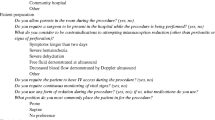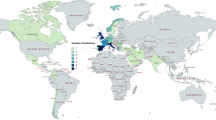Abstract
A detailed survey of intussusception reduction practices at the International Pediatric Radiology '91 meeting in Stockholm yielded 78 responses from radiologists representing 21 countries on six continents. Results indicate a striking lack of concensus on basic technical issues such as the type of contrast material or reducing agent, the pressure limits for reduction, the use of balloontip tubes, the role of sedation, manipulation of the abdomen during reduction, and duration of symptoms beyond which reduction would not be attempted. For example, while gas reduction has been strongly promoted in the literature during the late 1980's, only 34.7% of the respondants indicated that this was their principle choice of reducing agent. Among technique choices which produced significant correlations with outcome, it is noteworthy that pooled data suggest an eightfold increase in perforations among those using gas rather than liquid for reduction. Also, although 53.8% of respondants use parenteral sedation at least part of the time, those who reported using it regularly had significantly lower success rates than all other radiologists. This study provides a current sampling of international opinion in a subject of importance to all pediatric radiologists; and by linking the responses with reported outcomes suggests opportunities for further investigation.
Similar content being viewed by others
References
Hirschsprung H (1876) Tilfaelde af subakut tarminvagination. Hospitalstidende 3:321–327
Packard GB, Allen RR (1959) Intussusception. Surgery 45:496–505
Monrad S (1926) A study of acute invagination of the intestine in small children. Acta Paediatr (Uppsala) 6:31–52
Ravitch MM, McCune RM Jr (1948) Reduction of intussusception by barium enema; a clinical and experimental study. Ann Surg 128:904–917
Fiorito ES, Recalde Cuestas LA (1959) Diagnosis and treatment of acute intestinal intussusception with controlled insufflation of air. Pediatrics 24:241–244
Stringer DA, Ein SH (1990) Pneumatic reduction: advantages, risks and indications. Pediatr Radiol 20:475–477
Shiels WE, Keller GL, Ryckman FR et al (1991) Juvenile colonic perforation: experimental results and clinical applications. Scientific session presentation, International Pediatric Radiology '91 meeting, Stockholm, Sweden, May 29
Kuta AJ, Benator RM (1990) Intussusception: hydrostatic pressure equivalents for barium and meglumine sodium diatrizoate. Radiology 175:125–126
Guo JZ, Ma XY, Zhou QH (1986) Results of air pressure enema reduction of intussusception: 6,396 cases in 13 years. J Pediatr Surg 21:1201–1203
Santulli TV, Ferrar JM Jr (1955) Intussusception: an appraisal of present treatment. Ann Surg 143:8–17
Author information
Authors and Affiliations
Rights and permissions
About this article
Cite this article
Katz, M.E., Kolm, P. Intussusception reduction 1991: An international survey of pediatric radiologists. Pediatr Radiol 22, 318–322 (1992). https://doi.org/10.1007/BF02016243
Received:
Accepted:
Issue Date:
DOI: https://doi.org/10.1007/BF02016243




